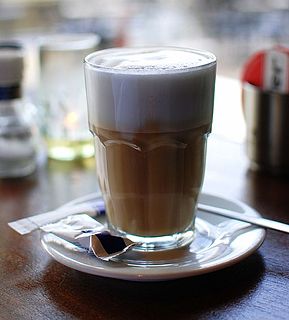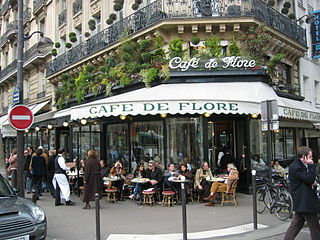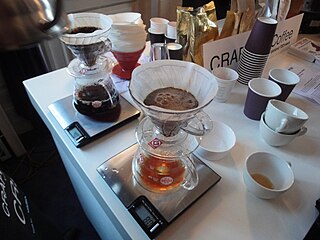
A White Russian is a cocktail made with vodka, coffee liqueur and cream served with ice in an Old Fashioned glass. Often milk or half and half will be used as an alternative to cream.

Caffè is the Italian word for coffee and probably originates from Kaffa, the region in Ethiopia where coffee originated. The Muslims first used and distributed it worldwide from the port of Mocha in Yemen, after which the Europeans named it mokka. Caffè may refer to the Italian way of preparing a coffee, an espresso, or occasionally used as a synonym for the European coffee bar.

Common chicory, Cichorium intybus, is a somewhat woody, perennial herbaceous plant of the dandelion family Asteraceae, usually with bright blue flowers, rarely white or pink. Many varieties are cultivated for salad leaves, chicons, or roots, which are baked, ground, and used as a coffee substitute and food additive. In the 21st century, inulin, an extract from chicory root, has been used in food manufacturing as a sweetener and source of dietary fiber.

A latte is a coffee drink made with espresso and steamed milk.

Brewed coffee is made by pouring hot water onto ground coffee beans, then allowing to brew. There are several methods for doing this, including using a filter, a percolator, and a French press. Terms used for the resulting coffee often reflect the method used, such as drip brewed coffee, filtered coffee, pour-over coffee, immersion brewed coffee, or simply coffee. Water seeps through the ground coffee, absorbing its constituent chemical compounds, and then passes through a filter. The used coffee grounds are retained in the filter with the brewed coffee collecting in a vessel such as a carafe or pot.

A coffee filter is a coffee-brewing utensil, usually made of disposable paper. This enables it to trap the coffee grounds and allow the liquid coffee to flow through.

A coffeehouse, coffee shop, or café is an establishment that primarily serves coffee, related coffee drinks, and – depending on country – other drinks including alcoholic. Some coffeehouses may serve cold drinks such as iced coffee and iced tea; in continental Europe, cafés serve alcoholic drinks. A coffeehouse may also serve some type of food, such as light snacks, sandwiches, muffins or other pastries. Coffeehouses range from owner-operated small businesses to large multinational corporations.

Irish coffee is a cocktail consisting of hot coffee, Irish whiskey, and sugar, stirred, and topped with cream. The coffee is drunk through the cream.

Coffee is a brewed drink prepared from roasted coffee beans, the seeds of berries from certain Coffea species. The genus Coffea is native to tropical Africa and Madagascar, the Comoros, Mauritius, and Réunion in the Indian Ocean. Coffee plants are now cultivated in over 70 countries, primarily in the equatorial regions of the Americas, Southeast Asia, Indian subcontinent, and Africa. The two most commonly grown are C. arabica and C. robusta. Once ripe, coffee berries are picked, processed, and dried. Dried coffee seeds are roasted to varying degrees, depending on the desired flavor. Roasted beans are ground and then brewed with near-boiling water to produce the beverage known as coffee.

Rotogravure is a type of intaglio printing process, which involves engraving the image onto an image carrier. In gravure printing, the image is engraved onto a cylinder because, like offset printing and flexography, it uses a rotary printing press.
Once a staple of newspaper photo features, the rotogravure process is still used for commercial printing of magazines, postcards, and corrugated (cardboard) and other product packaging.
Lloyd's List is one of the world's oldest continuously running journals, having provided weekly shipping news in London as early as 1734. It was published daily until 2013, and is in constantly updated digital format only since then.

Coffee preparation is the process of turning coffee beans into a beverage. While the particular steps vary with the type of coffee and with the raw materials, the process includes four basic steps: raw coffee beans must be roasted, the roasted coffee beans must then be ground, the ground coffee must then be mixed with hot water for a certain time (brewed), and finally the liquid coffee must be separated from the used grounds.

The history of coffee dates back to the 15th century, and possibly earlier with a number of reports and legends surrounding its first use. The native (undomesticated) origin of coffee is thought to have been Ethiopia, with several mythical accounts but no solid evidence. The earliest substantiated evidence of either coffee drinking or knowledge of the coffee tree is from the early 15th century, in the Sufi monasteries of Yemen, spreading soon to Mecca and Cairo. By the 16th century, it had reached the rest of the Middle East, South India (Coorg), Persia, Turkey, the Horn of Africa, and northern Africa. Coffee then spread to the Balkans, Italy, and to the rest of Europe, as well as Southeast Asia and then to America, despite bans imposed during the 15th century by religious leaders in Mecca and Cairo, and later by the Catholic Church.

Coffee substitutes are non-coffee products, usually without caffeine, that are used to imitate coffee. Coffee substitutes can be used for medical, economic and religious reasons, or simply because coffee is not readily available. Roasted grain beverages are common substitutes for coffee.

Kapeng barako, also known as Barako coffee or Batangas coffee, is a coffee varietal grown in the Philippines, particularly in the provinces of Batangas and Cavite. It belongs to the species Coffea liberica. The term is also used to refer to all coffee coming from those provinces. Barako in the languages of the Philippines means "stud", and is associated with the image of masculinity. Barako has a strong flavor and fragrance reminiscent of aniseed.

The AeroPress is a device for brewing coffee. It was invented in 2005 by Aerobie president Alan Adler. Coffee is steeped for 10–50 seconds and then forced through a filter by pressing the plunger through the tube. The filters used are either the AeroPress paper filters or disc shaped thin metal filters. The maker describes the result as an espresso strength concentration of coffee, but its most frequent use is more in the filter brew strength.

Grains of Selim are the seeds of a shrubby tree, Xylopia aethiopica, found in Africa. The seeds have a musky flavor and are used as a spice in a manner similar to black pepper, and as a flavouring agent that that defines café Touba, the dominant style of coffee in Senegal. It is also known as Kani pepper, Senegal pepper, Ethiopian pepper, and (historically) Moor pepper and Negro pepper. It also has many names in native languages of Africa, the most common of which is djar in the Wolof language. It is sometimes referred to as African pepper or Guinea pepper, but these are ambiguous terms that may refer to Ashanti pepper and grains of paradise, among others.

Coffeemakers or coffee machines are cooking appliances used to brew coffee. While there are many different types of coffeemakers using a number of different brewing principles, in the most common devices, coffee grounds are placed in a paper or metal filter inside a funnel, which is set over a glass or ceramic coffee pot, a cooking pot in the kettle family. Cold water is poured into a separate chamber, which is then heated up to the boiling point, and directed into the funnel. This is also called automatic drip-brew.



















